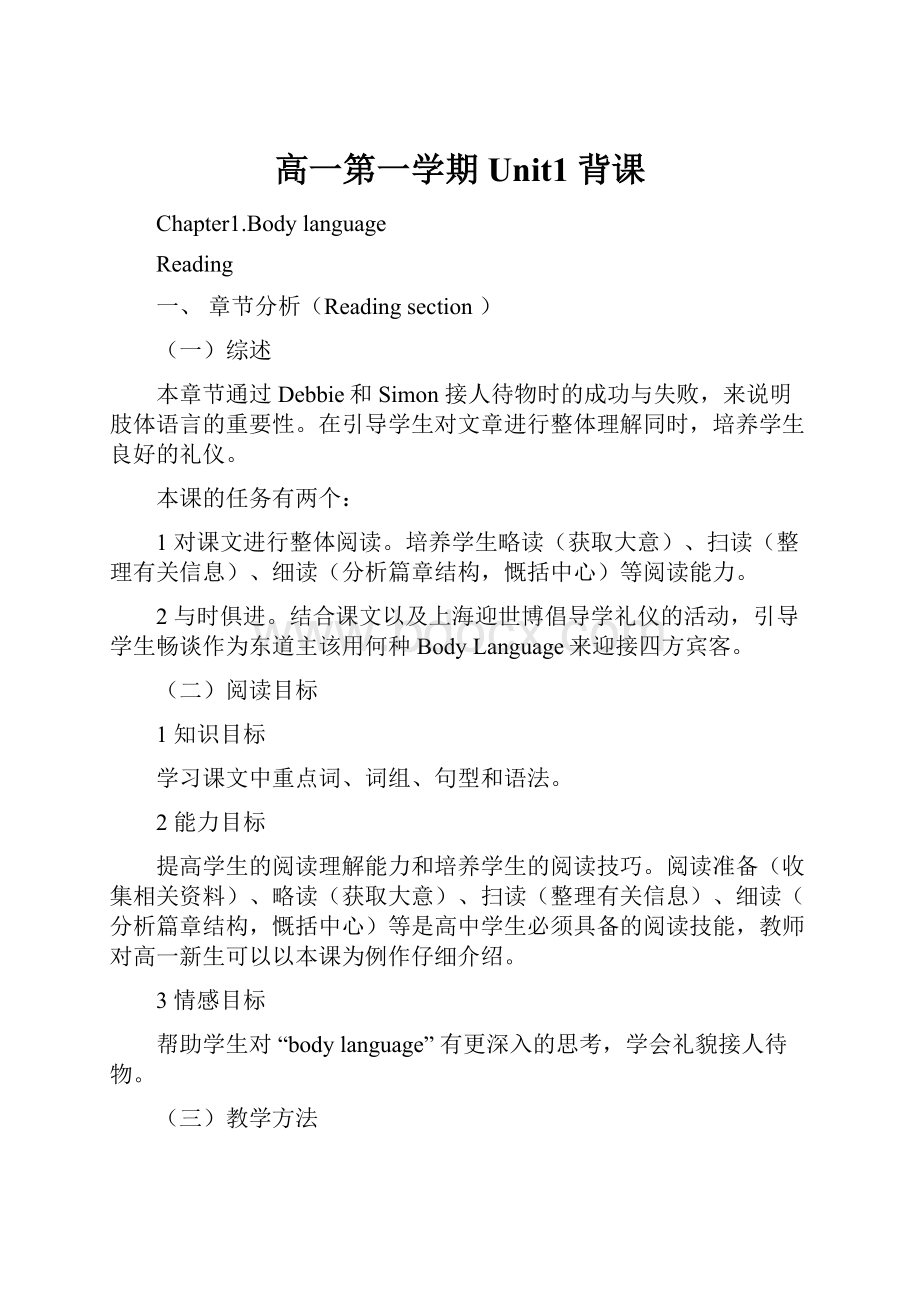 高一第一学期Unit1 背课.docx
高一第一学期Unit1 背课.docx
- 文档编号:27355785
- 上传时间:2023-06-29
- 格式:DOCX
- 页数:64
- 大小:69.61KB
高一第一学期Unit1 背课.docx
《高一第一学期Unit1 背课.docx》由会员分享,可在线阅读,更多相关《高一第一学期Unit1 背课.docx(64页珍藏版)》请在冰豆网上搜索。

高一第一学期Unit1背课
Chapter1.Bodylanguage
Reading
一、章节分析(Readingsection)
(一)综述
本章节通过Debbie和Simon接人待物时的成功与失败,来说明肢体语言的重要性。
在引导学生对文章进行整体理解同时,培养学生良好的礼仪。
本课的任务有两个:
1对课文进行整体阅读。
培养学生略读(获取大意)、扫读(整理有关信息)、细读(分析篇章结构,慨括中心)等阅读能力。
2与时俱进。
结合课文以及上海迎世博倡导学礼仪的活动,引导学生畅谈作为东道主该用何种BodyLanguage来迎接四方宾客。
(二)阅读目标
1知识目标
学习课文中重点词、词组、句型和语法。
2能力目标
提高学生的阅读理解能力和培养学生的阅读技巧。
阅读准备(收集相关资料)、略读(获取大意)、扫读(整理有关信息)、细读(分析篇章结构,慨括中心)等是高中学生必须具备的阅读技能,教师对高一新生可以以本课为例作仔细介绍。
3情感目标
帮助学生对“bodylanguage”有更深入的思考,学会礼貌接人待物。
(三)教学方法
采用任务型教学法组织教学,通过比较,讨论等具体活动,达到教学效果。
(四)重点和难点
1词汇学习
1)核心词汇
●senior
●appearance
●express/expression
●impress/impression
●middle-aged,well-dressed,part-time
●communicate/communication
●opposite
●greet
●cheerful
●employ(employer,employee)
●colleague
●customer
●gesture
2)拓展词汇
●sigh
●fax
●headline(练习D中)
●heading
3)词组和短语
●glanceat,
●getdownto,
●givesb.agoodimpression,makeagoodimpressionon…,
●withouthesitation,
●holdup,
●prefer…to,wouldratherdo…
2句型学习
●look(sound,smell,taste,feel)+adj.
●makesb.+v.原形
二、教学设计(TeachingDesigns)
教学内容
教学实施建议
教学资源参考
Pre-reading
为了更好地处理初高中衔接,建议老师用一个课时完成两个任务:
●介绍高中课本的结构特点;课文所涉及的内容;以及阅读时skimming和scanning技巧.
●根据课文主题,向学生展示一些生动形象并表示不同含义的肢体语言图片并与学生讨论它们所起的作用,从而调动学生学习积极性,激发学习兴趣,为顺利进入课文学习打下基础。
[具体处理这部分内容的建议见[链接1]对初高中衔接的处理]
[链接2课件:
bodylanguage1]。
中学英语合作网
《牛津英语教学参考》Page1
While-reading
这是本课的主体部分,也是老师要处理的重点,既要引导学生学习重点词汇和句型,又要提高学生的阅读理解能力,培养学生的阅读技巧。
●Skimming要求学生快速略读,获得课文的大概轮廓,能在有限的时间内运用skimming技巧,找到最基本的信息。
●Scanning由于课本上scanning全词填空太难,不符合由易到难的教学规律,故把课本第4页EReadandthink部分稍作修改变成scanning的内容。
要求学生运用scanning技巧,搜索需要的信息。
●Furtherunderstanding经过以上两个基础环节后,进入课文深层次的理解,要求学生能找出文中描写Debbie和Simon身体语言的词语,通过比较总结出两人接人待物的成功与失败的原因。
●Consolidationandconclusion把课本第2页CScanning部分进行适当修改,巩固刚学过的内容。
[具体处理这部分内容的建议见[链接3课件:
bodylanguage2]。
Post-reading
Discussion这是课文的拓展部分,也是进行情感教育部分。
结合课文以及上海迎世博倡导学礼仪的活动,引导学生畅谈作为东道主该用何种bodyLanguage来迎接四方宾客。
[链接1]
说明:
对初高中衔接的处理。
1师生的自我介绍。
Prepartion:
一个活页文件夹,一本纠错本,一本单词记忆本(选择)
Thereare6unitsinthebook,whichisdividedintosixparts,includingReading,Grammar,Listening,Speaking,WritingandMorereading.Whichplaysanimportantroleinthestudy?
Reading.Inthecollegeentranceexam,readingaccountsforabout25percent,whichisrelatedtoeverypart.Introductiontotwobasicstrategy.
2介绍高中教材的特点,介绍阅读中skimming和scanning的含义与技巧.
1)Whatisskimming?
Skimmingisareadingstrategy.Whenweskimapieceofreading,wereaditveryquicklyinordertogetthegeneralideaofthereading.Whenweskim,weskiptheunimportantparts.Therefore,whenweskim,weusuallyonlylookattitlesandheadings,picturesanddiagrams,andimportantsentences(usuallythefirstandlastsentencesofaparagraph)inthereading.Skimmingtakesonlyaminuteortwo,andithelpsusgetthegeneraloutlineofthereadingandfollowthewriter’sideamoreeasily.Itisawaytoprepareusforabetteranddetailedunderstandingofthewriter’sideas.
略读是一种阅读方式。
当我们进行阅读时,我们是在非常快速地阅读,目的是获地阅读材料的大概轮廓或意义。
在略读时,我们跳过不重要的部分。
因此,我们通常只看题目和段落标题、附图和图表以及重要的句子(一般是每个段落的第一句和最后一句)。
略读只需一二分钟,它帮助我们获得阅读材料的大概轮廓并使我们更好地跟上作者的思路,它为我们更准确、更仔细的理解作者的思想做好了准备。
2)Whatisscanning?
Scanningisareadingstrategy.Whenwescanapieceofreading,wereaditveryquicklyinordertogetspecificorsinglepiecesofinformation.Sowescantogetinformationabouttime,names,placesandnumbers,etc.Whenwescan,wealwaysskiptheirrelevantpartsandweonlyfocusonwhatweneedtofindout.
跳读是一种阅读方法。
当我们在扫读一篇阅读材料时,我们是在非常快速地阅读,目的是获得有关时间、姓名、地点和数据等的信息。
在跳读时,我们总是跳过不相关的部分,而只是集中注意我们需要发现的信息。
3)Whatisfurtherunderstanding?
Itmeanstheunderstandingofthedetailsaboutthereadingmaterial.Whenreadingit,weshouldknowaboutthewordsandexpression(recite,practiceandapplication),andinferthehiddenmeaningbehindthesentenceandparagraphsaccordingtothecertaincontext.Itisthefinalobjectiveofreading.
Practice(老师们可以用以下材料说明介绍skimming和scanning的阅读技巧。
)
EnglishManners
A
Whenwemeetsomeoneweknow,thesimplestthingtosayinEnglishis“Goodmorning”,“Goodafternoon”,or“Goodevening”.“Hello”and“Hi”areformsofinformalgreeting.Weavoidusingthemwithseniorsorinaveryformalsituation.“Howareyou?
”and“Howareyoudoing?
”areoftenusedtogreetfriends.Theyareusedeitherduringthedayorintheevening.“Howdoyoudo?
”seemstobeusedlessoftenthanbefore.
B
SomeformsofgreetingwhicharegoodmannersinChinaarenotconsideredsoinBritainorsomeotherEnglish-speakingcountries.Forexample,usuallyweshouldavoidgreetingaforeignfriendbysaying“Whereareyougoing?
”or“Wherehaveyoubeen?
”,whicharequitecommonamongfriendsinChina.Ifwedidaskeitherofthesequestions,theforeignfriendwouldthinkthatwewereaskingabouthisprivateaffairs.Neithershouldwegreetaforeignerbysaying“Haveyouhadyourdinner?
”.Hemightthinkyouwereinvitinghimtodinner!
Theseformsofgreetingareonlyacceptablewhentheyareusedwithclosefriends.
C
InmostEnglish-speakingcountriesshakinghandsisalsoaformofgreeting,andthebestkindofhandshakeisgentleandfirm.Closefriendsorrelatives,ontheotherhand,usuallydonotshakehandswitheachother;theyoftenexchangeaquickkissonthecheekwhentheymeetorpart.Men,however,don’toftenkissorembracewhengreetingeachother.
D
Menstilltendtoopendoorsforwomeninpublic.However,someyounggirlscannotstandthat.Nowadaysmoreandmorewomenareopeningdoorsformen!
E
Goodmannersaremadeupofmanysmallthings.Foreignfriendsorcolleaguescangetveryupsetifweforgettosayordosomethingproperly.Thiscanbeclearlyshownthroughthefollowingexample.
F
Oneday,onthedeskofadepartmentofficeinacollege,layaletterforavisitingAmericanprofessor.HerChinesecolleaguehappenedtopassby.Shesawit,pickeditup,andlatergaveittotheAmericanprofessor,saying,“MrsWillis,aletterforyoufromyourhometown.”Tohersurprise,thevisitingprofessorimmediatelyputonastiffface.Shedidn’tknowthereasonwhytheChinesecolleaguewasinterestedinherprivateaffairs.Atthesametime,theChineseteacherdidn’tknowthereasonwhyMrsWillistookoffence.
G
Thus,wehavealottolearnaboutEnglishmanners.Thenativespeakersaroundusofferverygoodexampleswhentalkingandacting.Englishbooks,TVprogrammesandtheInternetprovidelessonsaswell.Somedictionariesalsopresentlistsofcommonpoliteexpressions.So,wemusttryourbesttolearnmoreaboutEnglishmannersandpeople’swaysoflifesothatwecancommunicatewithforeignersmoreproperly.
Exercises:
A)Skimming:
ReadthefirstandlastsentencesofeachparagraphandmatchthesummariesinColumnⅠwiththeparagraphsinColumnⅡ.Thefirstonehasbeendoneforyouasanexample.
ColumnⅠ
a)Thingsthatmakeupgoodmanners
b)Agoodexampletoshowculturaldifferencesinmanners
c)Shakinghands,kissingandembracing
d)Openingdoorsandgoodmanners
e)Differentformsofgreeting
f)MannersinChinaandEnglish-speakingcountries
g)GettingtoknowmoreaboutEnglishmanners
ColumnⅡ
ParagraphA
ParagraphB
ParagraphC
ParagraphD
ParagraphE
ParagraphF
ParagraphG
(answer:
a)---E,b)---F,c)---C,d)---D,e)---A,f)---B)
(虽然这篇文章很长,但经过skimming环节,同学们基本能在较短的时间内,通过看每一段落的第一句和最后一句,找到每段的段落大意,理清作者的写作思路,为下一步寻找细节奠定基础。
)
B.Scanning:
Scanthetextandanswerthefollowingquestions.
Inwhatsituation(s)iseachofthefollowingused?
●“Goodmorning.”,“Goodafternoon.”,“Goodevening.”
●“Hello.”,“Hi.”
●“Howareyou?
”,“Howareyoudoing?
”
●“Howdoyoudo?
”
●“Whereareyougoing?
”,“Wherehaveyoubeen?
”,“Haveyouhadyourdinner?
”
(经过skimming环节后,同学们知道以上问题的答案应在第A段和B段去找。
)
Whenandwithwhomdopeopleexchangeaquickkissonthecheek?
(在第C段找。
答案:
relativesorclosefriendswhenmeeting)
HowmanywayshasthewritersuggestedtohelpuslearnmoreaboutEnglishmanners?
(在G段找。
答案:
3)
(同学们往往畏惧阅读长文章,从头到尾读下来,却不知文章到底讲什么。
通过学习理解文章的大意,知道在什么段落去寻找需要的信息,并为下一步深层理解奠定基础。
)
[链接2]
说明:
用ppt.(bodylanguage1)展示一些生动的bodylanguage图片,鼓励学生动口动脑,说出它们的含义。
Themanymeaningsofbodylanguage
(见课件:
bodylanguage2)
[链接3]
说明:
本部分建议采用任务型阅读教学方法。
通过略读、扫读、细读等不同手段来提高学生的阅读理解能力,从而培养学生的阅读技巧。
StepOneWarming-up
Lookatthepicturesonppt.Differentbodylanguage(faciallanguage)showssomedifferentfeelings.(Studentsusedifferentwordsesp.adj.todescribethem).
(具体处理见课件“bodylanguage2ppt.)
StepTwoTaskcycle---reading
1Skimming
Skimthestoryandlookatthephotoonthenextpage,andthentrytoanswerthefollowingquestions.
Wheredoesthestorytakeplace?
(intheSunbeamTravelCompany)
Whoarethepeoplesittingdown?
(DebbieandSimon)
Whendidthestorytakeplace?
(onaSaturdaymorning)
Whichpersonlooksthemostfriendly?
(Debbie)
2Scanning
Scanthepassageandfindtheanswertothefollowingquestions.
WhosatdownoppositeDebbie?
(Amiddle-aged,well-dressedwoman)
HowdidDebbiegreether?
(cheerfully)
WhowasMr.Yang?
(asenioremployeeinthecompany)
CanyoufindtwoexamplesofMrYang’sbodylanguage?
Whydidhedothethings?
(puthishandonSimon’sshoulders;gaveanencouragingsmile;totellhimwhythecustomerdidn’tprefertodealwithhiminafriendlyway.)
WhydidthecustomerprefertodealwithDebbie?
(进入下一环节的细读。
)
3Furtherunderstanding(通过比较两人不同的身体语言,得出文章的主题)
1)FindthedifferentbodylanguageofDebbieandSimon.
Debbie
Simon
greetcheerfully
sigh
holdherheadup
resthisheadonhishand
lookatthecustomer’seyes
lookdownwards
smile
notsmile
turnherheadorbodytowardsthecustomer
notturnhisheadorbodytowardsthecustomer
2)Question
Whydidcustomersprefertodealwi
- 配套讲稿:
如PPT文件的首页显示word图标,表示该PPT已包含配套word讲稿。双击word图标可打开word文档。
- 特殊限制:
部分文档作品中含有的国旗、国徽等图片,仅作为作品整体效果示例展示,禁止商用。设计者仅对作品中独创性部分享有著作权。
- 关 键 词:
- 高一第一学期Unit1 背课 第一 学期 Unit1
 冰豆网所有资源均是用户自行上传分享,仅供网友学习交流,未经上传用户书面授权,请勿作他用。
冰豆网所有资源均是用户自行上传分享,仅供网友学习交流,未经上传用户书面授权,请勿作他用。


 《C12343098汽轮机操作规程》要点.docx
《C12343098汽轮机操作规程》要点.docx
